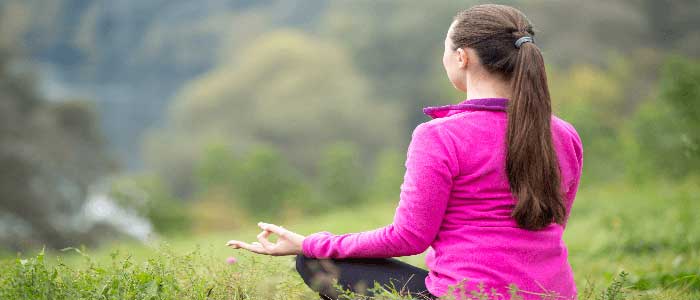Exercises to Relieve Back Pain

How to Relieve Back Pain through Exercise
“Oh, my aching back!” If this phrase repeatedly runs through your mind, then you are one of the millions of people who suffer from chronic back pain. Let’s face it, life is tough on our backs. We sit at computers all day, we carry things we probably shouldn’t be carrying, and we have more than our share of the “S” word (STRESS). These factors contribute to back pain that can and does, really mess with our quality of life.
Did you know that there are specific exercises you can do to help your body relax, and lessen the discomfort of back pain? Here are 5 different tips to help improve your day to day when dealing with back pain. Learn about the Egoscue Method (postural therapy), core exercises (breathing, meditation, strengthening your core), stretches to elongate the spine and help relax spasms, yoga and walking. These exercises are geared to improve the strength and the flexibility of the muscles that support your spine and back. Let’s explore these options:
Egoscue Method – Egoscue is a set of exercises designed to eliminate your body’s particular structural dysfunctions which are the source of your pain. The goal of Egoscue is to help your body position (your natural posture) change for the better. It is a process that is founded on the belief that the body can and does, heal itself. Created by Pete Egoscue, the Egoscue method has been used since the 1970s.
Core Exercises -“Strengthen your core” is a buzz word heard in just about any fitness facility. The abdominal and back muscles located in your core stabilize your spine and are invaluable to a healthy back. They play a vital role in providing your body the strength and ability to stay upright, as well as for all types of movement. If core muscles are in poor condition, additional stress is placed upon the spine as it supports the body, making back injury and back pain a very real possibility.
Relaxation techniques such as meditation and Diaphragmatic breathing are also believed to benefit overall health.
The practices of meditation and Diaphragmatic breathing can:
- Boost the circulation of oxygen levels.
- Lessen fatigue while exercising
- Aid in lowering blood pressure
- Help to reduce stress or anxiety.
- Strengthen deep pelvic floor muscles and function
Stretching – There are many options for stretching the back, making it more flexible and elongating the muscles. A tight back has less range of movement, making an injury more likely when simply bending over to put a fork in the dishwasher or pick up the newspaper. Keeping your back supple is as important as keeping it strong. For low to mid back pain, try these two stretching exercises:
MacKenzie Press-ups: Lay on your stomach, with your hand palms down mid-chest to lower shoulder level. Keeping your lower body flat, begin to “press-up”, raising your upper body while keeping your hands pressed firmly on the floor. Attempt to curve your back upward, with your head staying in line with your spine. Hold for 10 seconds, and repeat.
Pilates ball: lay on a Pilates ball, facing up. Let the curve of your back follow the shape of the ball, and just relax, feeling your back stretch as you breathe slowly and deeply.
Open/Close Book Exercise: Many videos for this rotational stretch can be found on the internet to aid in the explanation of this exercise. Lay on one side, with the upper leg bent at the knee and resting on the floor, or on a medicine ball as shown in this video*) adjacent to the lower leg, which remains straight. Palms are together, your arms are extended in front of you on the floor, pointing in the same direction as your feet. Slowly, move the upper arm in an arc (open the book) to rest on the opposite side of your body, following the motion of your arm with your head. When the movement is complete, both arms are laying on the floor, stretching out, but the legs are still in the original spot. Breathe, and stay in this position for several seconds. Then, move the upper arm (closing the book) back to meet the other arm, palm to palm. Repeat several times, and then switch sides.
Here are other exercises to relieve back pain from the Mayo Clinic
Yoga – Another proven option is Yoga. Many stretches in Yoga are excellent for flexibility and relieving back pain. There are Yoga classes at the YMCA, your local gym, or at studios in just about every neighborhood in America. Or, you can purchase a DVD to instruct you on the practice of Yoga in the comfort of your own home.
Walking – And finally, try the good old standby! WALKING. Yes, walking can help reduce back pain. A brisk walk will strengthen your bones and muscles. This includes your feet, legs, hips, and core as well as the muscles in your back. It also gets the blood flowing, which promotes healing, and helps relieve stress.
If trying these options still doesn’t help manage your pain, you should schedule a consultation with Dr. Jones-Quaidoo. Dr. Jones-Quaidoo specializes in back pain conditions, degenerative spine conditions such as degenerative disc disease, trauma, slipped or herniated discs, osteoarthritis, and spinal stenosis, and more. Dr. Jones-Quaidoo has received the prestigious honor of being voted by his peers as one of D Magazine’s “Best Doctors in Dallas”; rest assured that you are consulting with a well-known and respected specialist in his field.
